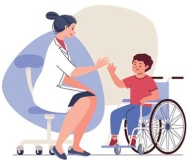institutional bias had to be reworked. Now, more funding goes into keeping people with disabilities where they belong – at home with supports – rather than in facilities.
HEALTH INSURANCE DISCRIMINATION
After the ACA, for the first time insurance companies could not deny coverage, limit benefits, or cancel coverage due to pre-existing conditions. Although health disparities still exist, this was a huge step in anti-discrimination and protection of those with disabilities.
PHYSICIANS' PERCEPTIONS: DISABILITY & HEALTHCARE
82.4% reported that people with significant disability have worse quality of life than nondisabled people. Only 40.7% of physicians were very confident about their ability to provide equal quality care to patients with disability.
ncbi.nlm.nih.gov/pmc/articles/PMC8722582

NEXT STEPS
Recently the National Center for Disability, Equity, and Intersectionality (formerly the Center on Dignity in Healthcare for People with Disabilities) did a gap analysis which determined disparities in four key areas:
- Prenatal diagnosis
- Mental health
- Organ transplants
- End-of-life Care
Findings included negative perceptions regarding prenatal diagnosis, lack of integrated physical/mental health care despite comorbidities, bias in quality of life resulting in inequitable eligibility for transplants, and avoiding misdiagnosis ("diagnostic overshadowing) and the need to use person-centered planning for end-of-life care. The committees created recommendations to address these concerns for prenatal, mental health, transplant, and end-of-life care. The recommendations are helpful for both families and health professionals, and there are "easy read" versions for people with intellectual/developmental disabilities.
Another paper on 25 years of the ADA suggested that consideration be given to the UN Convention on the Rights of People with Disabilities, which still hasn't happened.2 Although the ADA prohibits discrimination, the CRPD takes it further as a civil rights issue. For example, it is a human rights issue and rather than "distinguishing between people who are perceived as independent and valued in society from those who are dependent and devalued," it has a broader definition of equality based on supports and accommodations.
There is now recognition of people with disabilities as an underserved population experiencing disparities in healthcare. Individuals with disabilities and their families need to be aware of their rights. If they think there is discrimination in healthcare, they can contact Protection and Advocacy, sometimes called Disability Rights, in their state. More is being done in this area by national organizations, but more still needs to be done.•
ABOUT THE AUTHOR:

Lauren Agoratus, M.A. is the NJ Coordinator for Family Voices, NJ Regional Coordinator for the Family-to-Family Health Information Center, and Product Development Coordinator for RAISE (Resources for Advocacy, Independence, Self-Determination, and Employment). She also serves as NJ representative for the Caregiver Community Action Network as a volunteer. Nationally, Lauren has served on the Center for Dignity in Healthcare for People with Disabilities transplant committee (antidiscrimination), Center for Health Care Strategies Medicaid Workgroup on Family Engagement, Family Advisor for Children & Youth with Special Health Care Needs National Research Network, National Quality Forum-Pediatric Measures Steering Committee, and Population Health for Children with Medical Complexity Project-UCLA. She has written blogs and articles nationally, including publications in 2 academic journals (pubmed.ncbi.nlm.nih.gov/?term=agoratus+l). Lauren was named a Hero Advocate by Exceptional Parent Magazine (epmagazine.com Archives June 2022).
FIGHTING DISCRIMINATION: RESOURCES
HEALTH EQUITY FRAMEWORK FOR PEOPLE WITH DISABILITIES
ncd.gov/sites/default/files/NCD_Health_Equity_Framework.pdf
NATIONAL CENTER FOR DISABILITY, EQUITY, AND INTERSECTIONALITY
Recommendations thinkequitable.com/subcommittees
AUCD'S NATIONAL CENTER ON DISABILITY IN PUBLIC HEALTH nationalcenterdph.org
NATIONAL INSTITUTES OF HEALTH
Persons with Disabilities as an Unrecognized Health Disparity Population ncbi.nlm.nih.gov/pmc/articles/PMC4355692
NATIONAL ASSOCIATION OF COUNTY AND CITY HEALTH OFFICIALS
naccho.org/programs/community-health/disability
PROTECTION AND ADVOCACY (DISABILITY RIGHTS)